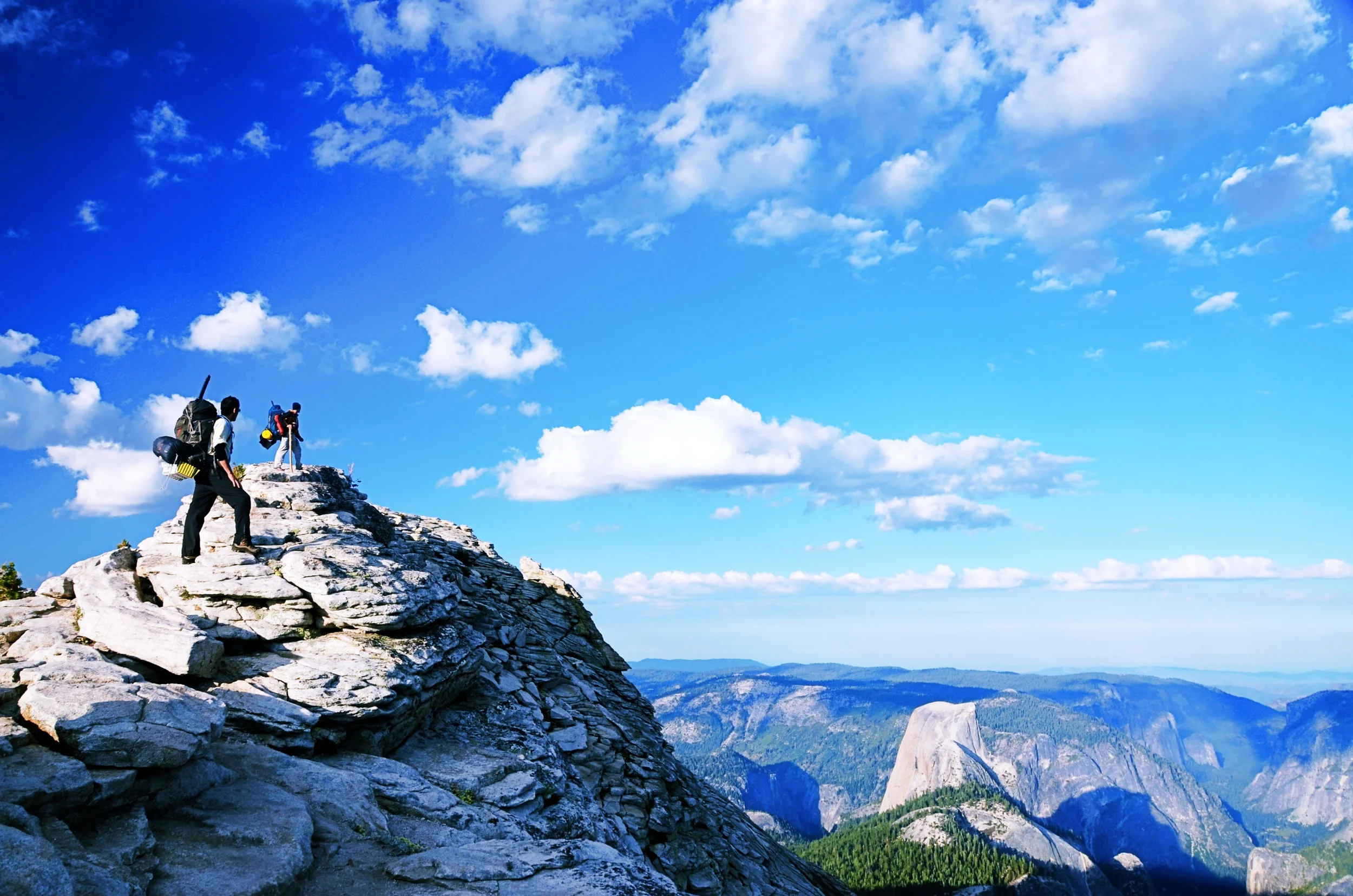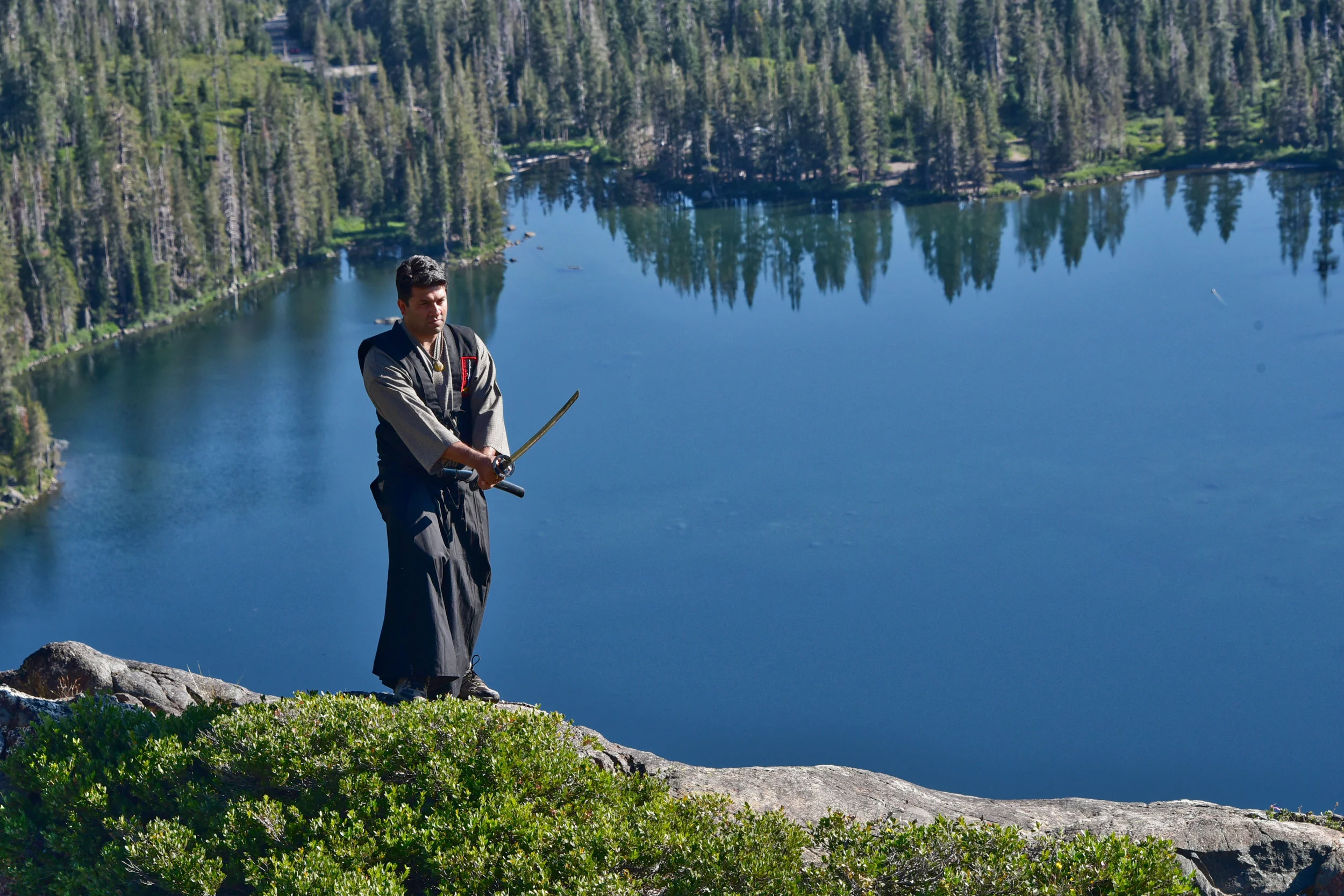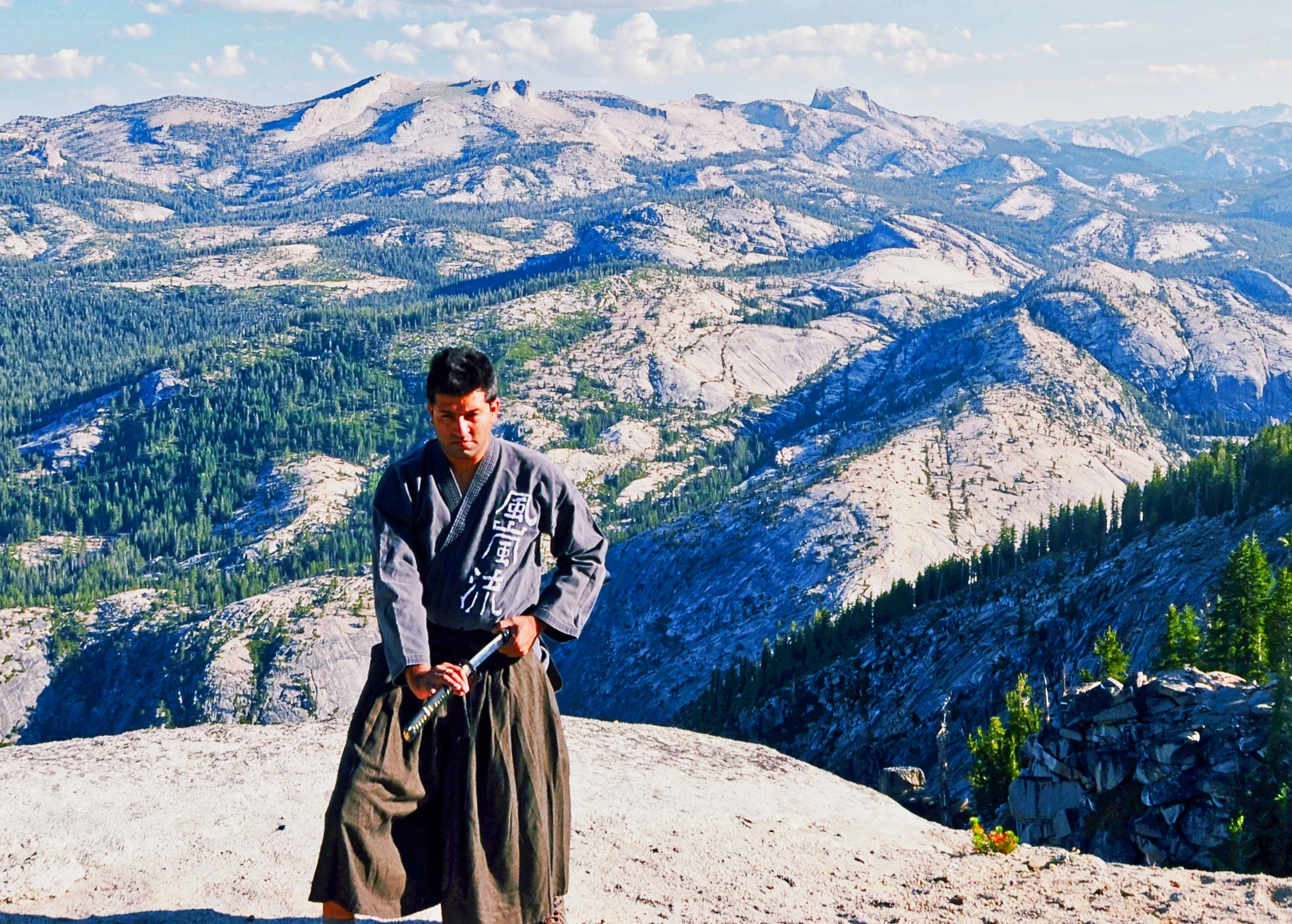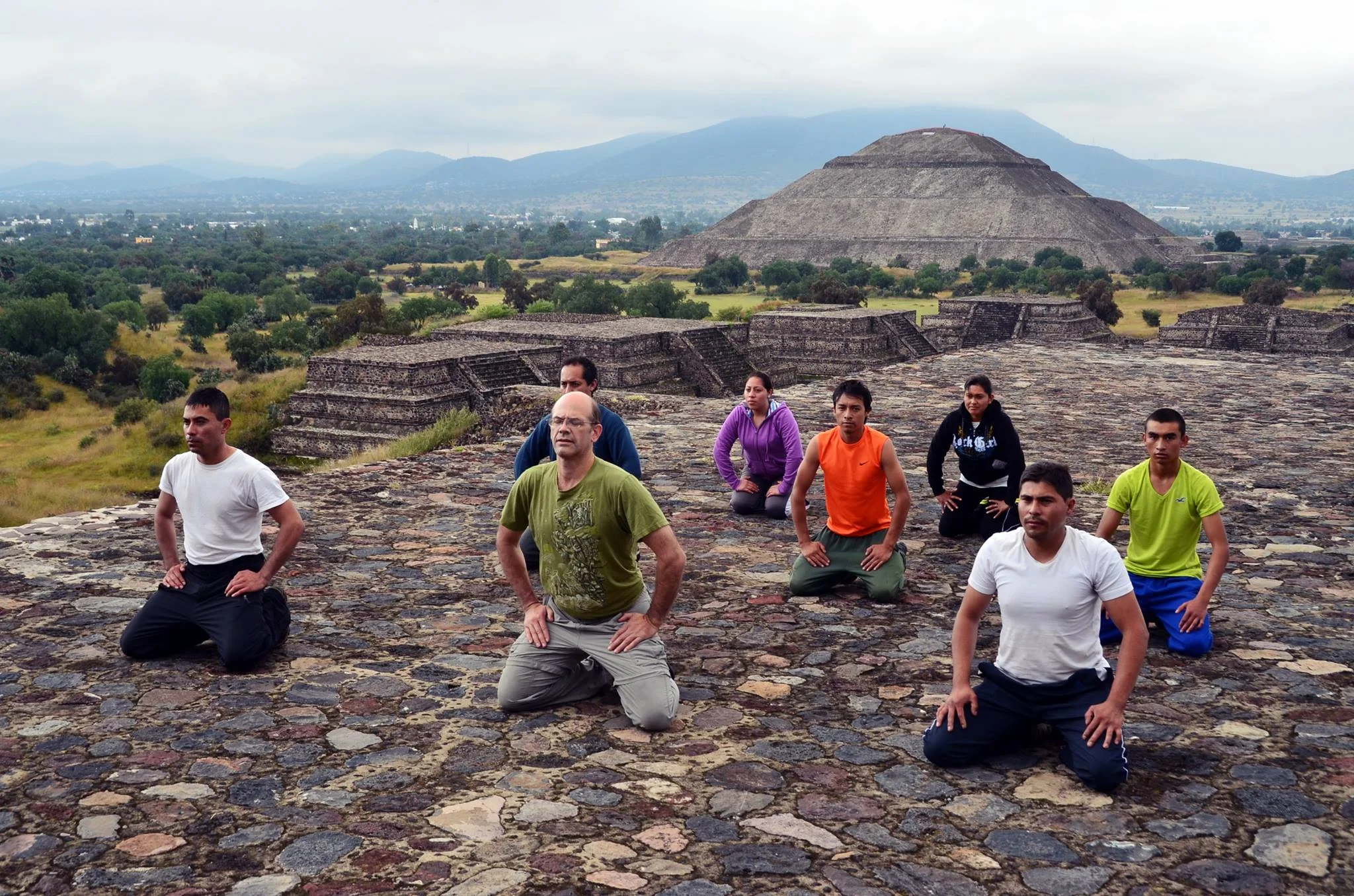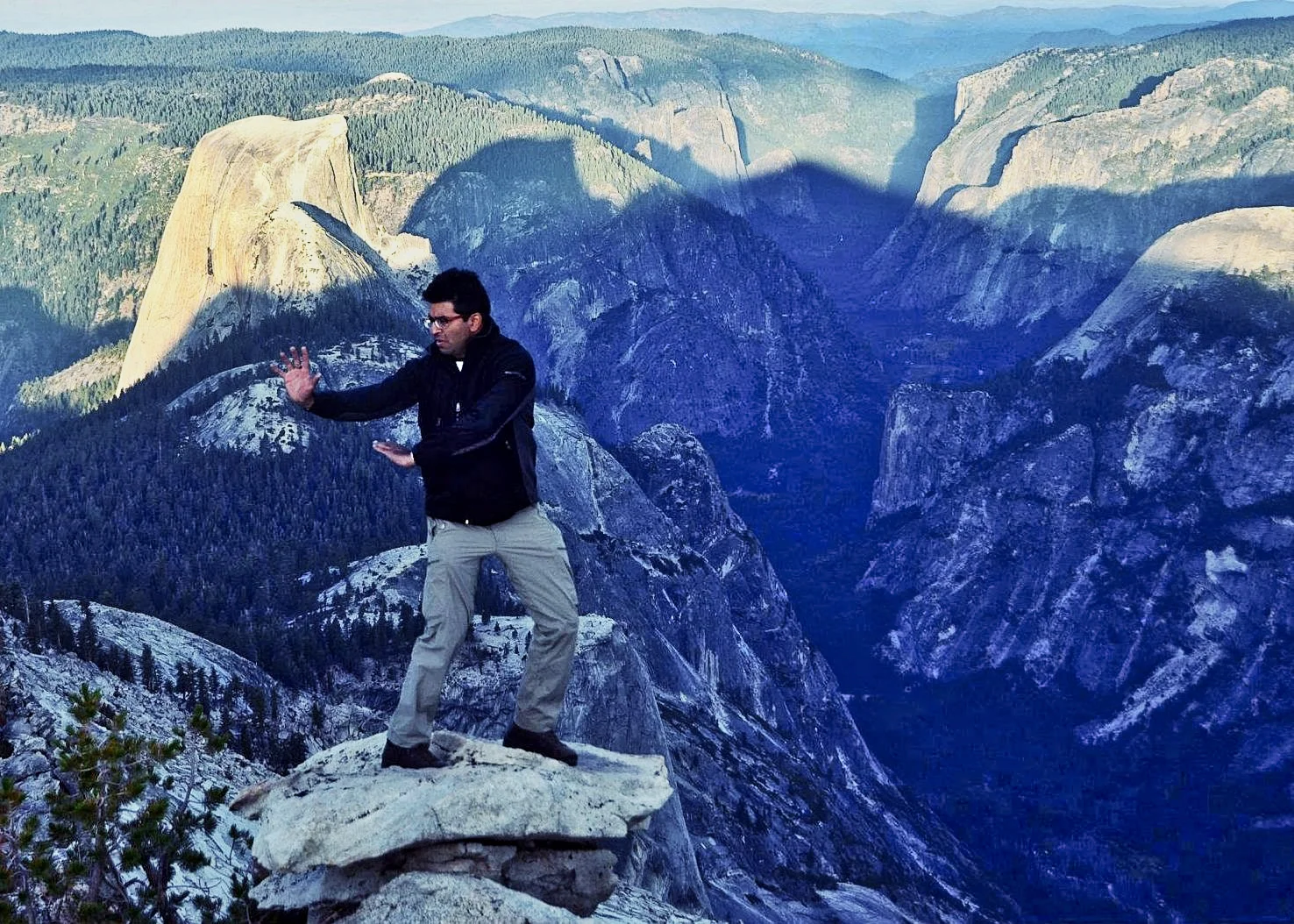State of the Samurai Mind, by Mahipal Lunia, Sensei
Shugyos are a form of austere training that introduce one to oneself. This method of training emerged during the Tokugawa period starting in mid 1600s. Shugyos have a a way of evoking some profound issues and learnings along their path including facing ourselves and our fears. It is a sacred pilgrimage that allows us to face our crap on our terms, rather than wait for the "Great Spirit" to bring it to us.
During our drive to the Shasta shugyo, I introduced students to some of the Yamabushi/Samurai history and religion. Understanding culture/context is critical to both grok and to ultimately transcend that philosophy. We talked about the Tokugawa period and how it changed the face of Japanese Martial Arts:
The Tokugawa period experienced peace for 150 years. The samurai went from being battle tested to testing their concepts in a dojo. This was a period of conceptualization, leading to some interesting amagamations. For eg. Shintoism, Shugendo, Zen, Confucianism, Daois, Buddhism and Bushido started merging to form an uniquely Japanese worldview.
The Tokugawa period saw three luminaries who have defined Japanese martial arts to this day:
1. Yagyu Munenori (author of The Life Giving Sword): Munenori taught kenjutsu to two Tokugawa shoguns and founded the Shinkage ryu system. Munenori was deeply influenced by the Zen priest Takuan. The major themes of Takuan's teachings, that of non attachment and non-violence shine through Munenori's book. To me this was beginning of the Do (way) creeping into the traditional Japanese jutsu (skill) arts. Watch the movie "Shoguns Samurai (1978)" if you want to track Munenori in popular culture.
2. Yamamoto Tsunetomo (author of The Hagakure): This book is a collection of around 1300 anecdotes on the Bushido (Way of the Warrior). It is the bible on how a samurai chooses to live and die. In popular culture, the movies Ghost Dog and Le Samourai give a glimpse of the Hagakure.
3. Miyamoto Musashi (author of The Book of Five Rings): I doubt there is a serious martial artist who has not read his no nonsense but hard to understand book. Numerous movies share the exploits of the man who was never defeated in his sixty plus duels.
As expected, the Shasta shugyo saw a lot of fears and issues come to the forefront especially during testing. The environment added some serious pressure too: 100+ degrees weather, exposed backcountry and icy cold glacial waters made it tough. We hiked through the wilderness past two lakes to find a spot by the cliff's edge to begin our journey.
The test started with gusto. The students had finished a their first hundred punches in Kibadachi (horse stance) at the edge of a cliff. But I saw some eyes glaze and felt minds getting ready to give up on the Kibadachi. So, it was time to bring their spirits up while teaching them something new - a good time to bring in some of the history and concepts. This also gave them the time to "raise their spirits" and perhaps find themselves in the process:
"Antero Alli, a renegade theatre facilitator taught me the mind can be a liar and a whore. It always drew a laugh but there is such profound truth in it. So pay attention. The mind will run like a recorder and play false stories, and these stories then run your life. The mind does not go on the hard path, but on what serves it quickly. Hence bringing awareness to this process is important not only to gain a certain mastery of yourself, but to also accelerate your martial performance.
What I find most fascinating about the Tokugawa period is the marriage of Jutsu (Skill) with Zen, giving rise to the DO, the WAY. The fear invoking Katana went from the Life Taking Sword to the Life Giving Sword. The period of peace afforded the Samurai the luxury to conceptualize, to experiment. This molting, discarding of the old world to enter into an expanded new world, was a profound step forward.
We begin to see the movement from violence to personal development. This does not mean the loss of skill, but rather skill with awareness, absolute responsibility.
This period started the process of brining the mind/awareness into the study of martial arts. The many distinctions made by the monks on the states of mind were now bought into the study of the arts especially five key states of mind. These are:-
Shoshin: (初心) Beginners Mind
Zanshin: (残心) Steady/Lingering Mind
Mushin: (無心) Empty/No Mind
Fudoshin: (不動心) Immovable Mind
Senshin: (先心) Pure/wakeful Mind."
The sun was beating down overhead and the edge of the cliff sent it's dire warning while Mt. Shasta dominated the entire landscape. Time to return to Kibadachi (horse riding stance) and deliver more punches. I saw the beads of sweat, and fear on their faces. With courage, the students took their spots on the cliff's edge. They finished their 100 and then it was time for a short physical break.
"I know you have done these punches thousands of times. But you've got to arrive at it with Shoshin: (初心) Beginners Mind. In so many ways you are doing these punches for the very first time given the edge of this cliff. A beginners mind is where you arrive at the experience without preconceived notions or the need to perform. I love the book Zen Mind, Beginners Mind by Suzuki Sensei. There is this one quote in it that captures the heart of this state of awareness.
“If your mind is empty, it is always ready for anything, it is open to everything. In the beginner's mind there are many possibilities, but in the expert's mind there are few. ” ― Shunryu Suzuki
There is this story of Master Nan-in, a renowned Zen teacher in the Meiji period. It is said he once had a professor visit him to learn about Zen. Master Nan-in welcomed him with a traditional cup of tea, and started to pour. Soon it was overflowing, the professor unable to take anymore screamed out that the cup was full, and it could hold no more. Nanin responded that just like this cup, so was the professor, full with his ideas and opinions. No more would go in. How would he be able to experience Zen, if his own preconceptions blocked the way? Empty Your Cup if you want to receive. This is the beginners mind."
The students looked at me wondering how this was relevant, especially now they were at the cliffs edge. I continued, "Leave your learnings behind, you are in the lap of beauty and peril. Open yourself to this experience. Don't worry about your performance or about the environment being beautifully harsh. Just Do It, and see what unfolds thanks to this new environment. Be childlike and come into deep play."
It was time for atemi combinations in tenshin (attack formations). 12 strikes within the system, each with 10 specific uses/henka. I called the attacks out, the students demonstrated in this new hostile environment. The temperature climbed into the low 100s, and their faces gleamed with sweat and doubts of this was all worth it. They requested a quick water break. I nodded with a stern "3 minutes." They ran to fetch their precious water.
"I have noticed that some of you are in a great hurry to move from one technique to the next. You are maintaining your awareness during and after the technique is completed. This is Zanshin: (残心): the Lingering Mind, the state of awareness from a position of advantage and readiness to move to whatver is needed next. "Zanshin is described as lingering mind, remaining mind or vigilant mind. Your attention is on eveything around you and your opponent. With zanshin you are totally connected with the enviornment, finding a way to marvel even at this perilious beauty of Shasta. I fondly remember Sastri Sensei making us do blindfolded randori. Sometimes my dojo mates would even use weapons to attack. This developed both sensitivity and awareness of the whole enviornment - without sight. This helped build zanshin in all we did at that small dojo."
"Right presence of mind means that the mind or spirit is present everywhere, because it is nowhere attached to any particular place......
......The instructor’s business is not to show the way itself, but to enable the pupil to get the feel of this way to the goal by adapting it to his individual peculiarities."
Zen in the Art of Archery.
(Read this book. Buy two copies, yes it is that good.)
All right 3 minutes up." I said, "Back to the test. Show me Geri/kicks."
They started with furor. The job of the test is to get them to their breaking point, and to then push them a little more to help them reform a new nucleus. These new levels of freedom, the things they thought were impossible, are now their possibilities. This happens after the mind gives up resisting all old stories and the heart continues to drive on.
"Get on one of those rocks and give me one hundred kicks. Careful that you maintain your balance, its a nice big drop down there." They hurried, trying to find a safe rock and I redirected the two senior students to a more worthy challenge. Their moods and faces changed.
Good, now perhaps they could experience their edge.
"You have done this kick thousands of time. It is in you. Execute. Suspend your doubts, including the technique or the lovely 1000 foot plus drop. Hajime (begin)."
They started somewhat in fear and soon were now executing their kicks with few hiccups. 100 round kicks atop a 1000 foot cliffedge in 100 plus weather is challenging. Dont take my word on it, try it.
"When you stopped worrying about the kick or that fall , you started to experience Mushin: (無心) No Mind. You have entered the realm of unconscious competence. I remember reading somewhere how Tohei Sensei once described this state. He compared it to driving a car. He stated you dont think about all the things you need to do like accelerate, change the gears or turn the wheel. You operate that car without conscious thought. The goal is to be able to fiercely express yourself physically without conscious thought during conflict. That was his description of Zanshin.
You have heard me talk a lot about Stopping the World, well this is stopping the world as you perform action. The Bhagwad Gita, set in the battlefield of Kurukshetra talks of this beautifully. Sri Krishna tells the warrior Prince Arjuna to be based in pure awareness (no thoughts) while performing his actions. So while this is called no mind, a better term for it would be no thoughts while performing your action. Just perform it from that space of complete awareness."
"If you gaze at a single leaf on a single tree, you do not see the other leaves. If you face the tree with no intention and do not fix your eyes on a single leaf, then you will see all the many leaves. If your mind is preoccupied with one leaf, you do not see the others, if you do not set your attention on one; you will see hundreds and thousands of leaves."
The Heredity Book of War by Yagyū Munenori
The heat had become unbearable, the granite rocks were now steaming hot. It was time for a short break. We climbed up to Heart Lake in our Gis. The lake was brisk from being freshly fed from snow and glacier. Not very deep, but perfect to mix things up. The students entered the water. One newer student, however, seemed perplexed.
Now we began with locks and randori, in the cold water, in some places neck deep. This newer student started freezing up, tears rolling down those expressive eyes. The student later confided that it was at that moment the almost gave up.
One particular body grab while submerging into the cold water froze that student completely. I screamed out "don't fight on so many fronts. You can't win against the environment, the opponent and yourself at the same time. Accept things as they are, and move, do what you know."
With hesitation, the student followed the instructions. Sinking deep into the water, slipping out of the lock the student applied Kansentsuwaza (arm bar) on the opponent.
BINGO.
Suddenly the spirit came back, and tears flowed again. The test flowed with much more ease and finesse after that. The student had accepted the challenges with a new found calmness.
"When you keep at your goal with calmness and fortitude, that is Fudoshin: (不動心) Immovable Mind. You are aware of everything around you, your environment, your fears and your opponents. Despite looming death or failure, you maintain a state of calmness and perform your actions, your sacred duty.
This was a prized state for the Samurai. It showed up as courage against unsurmountable odds. Fudoshin is the stuff of the truly Great. Tsukahara Bokuden, captured this spirit well when he said: "Mental calmness, not skill, is the sign of a matured samurai."
This maturity comes from accepting things as they are, and making peace with our greatest fears, and our own death. This can't be avoided, and yet once you make peace with them, it opens the doorways to freedom. If you want to learn more about this, to understand the Bushido, read the Hagakure:"
The Way of the Samurai is found in death. Meditation on inevitable death should be performed daily. Every day when one's body and mind are at peace, one should meditate upon being ripped apart by arrows, rifles, spears, and swords. Being carried away by surging waves. Being thrown into the midst of a great fire. Being struck by lightning, being shaken to death by a great earthquake. Falling from thousand-foot cliffs, dying of disease, or committing seppuku at the death of one's master. And every day, without fail, one should consider himself as dead. This is the substance of the Way of the Samurai.
Tsunetomo Yamamoto, Hagakure
As I seek the threads that connect, the commanality between the Samurai and the Kshatriyas (warriors of India) continues to amaze me. The Bhagwad Gita for example provides a great understanding of this concept. Pay attention to this verse, from Sri Krishna to his protege Prince Arjuna.
"yoga-sthah kuru karmani sangam tyaktva dhananjaya siddhy-asiddhyoh samo bhutva samatvam yoga ucyate"
"Be steadfast in yoga, O Arjuna. Perform your duty and abandon all attachment to success or failure. Such evenness of mind is called yoga" The Bhagwad Gita
"This evenness of mind, that calm spirit, that fortitude, that graceful acceptance of it all - this is the stuff of champions. Fudoshin."
It was time to end today's part of test for the day and to hike back to our campsite. The worn-out students nearly passed out, thinking of the rest of the test to be held at the foot of an icy cold waterfall.
"Why should we worry about these old distinctions? Do they even apply to us today?" asked one of my more skeptical student's.
I looked at this particular student with gentleness, thinking back of the time when I was him. Throwing a thousand questions was the norm with Sastri Sensei. I smiled. I love it when my students challenge me, it helps me grow. It is in this process my students transform into my teachers.
Better distinctions make for better decisions, esp when it comes to what we want, and how we show up. It is in distintions that true genius is born."
"In todays hyper short attention spans, these qualities are even more important. So yes we need to be grateful to those ancestors on the path, the Samurai. Their genius was merging seemingly opposite worldviews of war and self perfection . The Chinese influence here cannot be understated. "
"The Zen masters were deeply influenced by the Chan masters in China. And of course the Chinese got it from Boddhidharma, an Indian monk. The thread of mind trainining is something that runs thousands of years. These warrior monks did not buy into mere ideology. They experimented fiercely and proved it to themselves. You could call haps the longest running scientific experiment.
"You are free to check it our for yourself" I winked. He laughed realizing he walked into a trap he sought to set or perhaps the freedom he could discover. Only he can decide. We parted ways for the night.
A week or so passed, the same student asked me "what is the purpose of all these distinctions/"
"Oh one more distinction for you tonight. The purpose is to get to what the Japenese would call Senshin: (先心) Purified Mind; an enlightened attitude. This is a state where the mind is free from everything that is not in Ai or harmony. One would say this is a state without self image. When without self image, or ego, you can enter into harmony (Ai) with everything. This is the true pursuit of mastery. Without Senshin there would be no compassion, no empathy. You would only have a Life Taking Sword, no Life Giving Sword. This state of mind serves humanity, and perhaps everything." I paused for a minute then concluded "the very word Samurai means to serve, does it not?"
He nodded.
He asked "How will I know I am embracing all these states of mind Sensei? How do I know am not just caught in perpetual back and forth in my own mind or as you call mental masturbation?"
I laughed out loud: the student listens, even if selectively. Got to find humor and shock value if certain concepts are to stick in their minds. Got to throw a lot of shit at them, and hope at least some of it sticks.
"You are going to love this. You have all those states and more when you have experienced Satori and Shibumi. Sudden enlightenment and unobstuctive elegant truth. That is a lifetime study, and yet happens in an instant. Highly recommend you read Trevanian's novel Shibumi, it might be the easiest way into these truths."
Shibumi has to do with great refinement underlying commonplace appearances. It is a statement so correct that it does not have to be bold, so poignant it does not have to be pretty, so true it does not have to be real. Shibumi is understanding, rather than knowledge. Eloquent silence. In demeanor, it is modesty without pudency. In art, where the spirit of shibumi takes the form of sabi, it is elegant simplicity, articulate brevity. In philosophy, where shibumi emerges as wabi, it is spiritual tranquility that is not passive; it is being without the angst of becoming. And in the personality of a man, it is . . . how does one say it? Authority without domination? Something like that.”
Nicholai’s imagination was galvanized by the concept of shibumi. No other ideal had ever touched him so. “How does one achieve this shibumi, sir?”
“One does not achieve it, one . . . discovers it. And only a few men of infinite refinement ever do that. ”
“Meaning that one must learn a great deal to arrive at shibumi?”
“Meaning, rather, that one must pass through knowledge and arrive at simplicity.” ― Trevanian, Shibumi
I hear you that is can be confounding. But this Enlightened Simplicity has always been the purpose of all true art. The great Irish poet James Joyce coined the term Aesthetic Arrest. To me this also points towards that same state of mind, state of being. He states that proper art is one which does not create desire nor repulsion in the observer. The art rather holds them in stillness, in the Aesthetic Arrest of the moment. Beautiful is it not, Ireland and Japan. They could not be further apart, yet arrive at the same conclusion. Threads that connect. Something to pay close attention to."
It was getting late, the call of good home cooked food was irresistable. Tonight it was going to be a simple daal-chawal (lentil soup and basmati rice), cooked to perfection. The sweet aroma of the basmati rice and spicy daal made me salivate. Now cap that with a cup of fine chai with ginger, saffron and cardamom, it was time to go.
"I will close with this. There is an old adage in India, and you have seen it on my Coat of Arms. Satyam Shivam Sundaram. It roughly translates into that which is True, is Good, is Beautiful/Sublime. I try to track the sublime/beautiful, in it I find what is Good, that which is True."
"You got to find your path in. For me BEAUTY works. Now got to go to that beautiful meal that awaits me" I laughed as we walked to the carpark.
These States of Samurai Mind are key signposts along the way, the way to yourself. I hope you arrive at it in the most exquisite manner. May your path be filled with beauty that stills your mind, in the moment. For in it you would have discovered the truth, Your TRUTH. The path with a heart, Your HEART. That is the true secret.
Mahipal Lunia
www.MahipalLunia.com
www.MountainViewAiki.com
